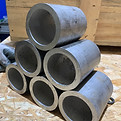316Ti Stainless Steel (1.4571)
Titanium-stabilised alloy for long-term strength and corrosion resistance in high-heat, high-risk environments.
316Ti Stainless Steel
316Ti stainless steel (1.4571) is a high-performance variant of the 316 family, specifically engineered for high-temperature environments where structural stability and resistance to intergranular corrosion are critical. The alloy is stabilised with titanium, a deliberate addition that binds with carbon to prevent carbide precipitation during welding or prolonged thermal exposure.
This makes 316Ti especially suitable for welded pressure vessels, heat exchanger systems, and chemical process equipment operating above 500°C. The presence of molybdenum further enhances its ability to resist chloride-induced corrosion and pitting, while its austenitic structure ensures reliable strength and formability for complex fabricated parts.
Whether used in marine environments, high-temperature reactors, or hygienic food-grade systems, 316Ti delivers extended service life and reduced risk of failure under cyclic thermal and chemical stress.
AVAILABLE FORMS
Intamet offers 316 Ti in a wide range of forms, including the below:

Tubes & Pipes

Hollow Sections

Fitting & Flanges

Round Bars

Sheet & Plate

Angles

Special Sections

Flat Bars

Hollow Bars
FAQs: 316Ti Stainless Steel
Need assistance or more information?
Get in touch with us today!
Have questions or need more details about this product?
Our team is here to provide expert guidance and ensure you have all the information you need to make the right choice for your project, contact us today with an enquiry!
